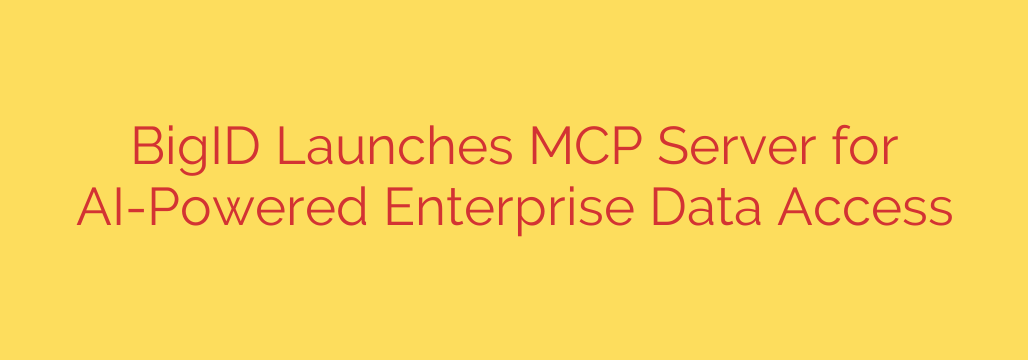
Unlocking Enterprise AI: A New Frontier in Secure Data Access
The era of generative AI is not just coming—it’s here. Businesses across every sector are racing to integrate Large Language Models (LLMs) and other AI tools into their workflows to boost productivity, uncover insights, and innovate faster. There’s just one monumental roadblock: your data.
Connecting a powerful AI to your company’s sensitive internal data—customer information, financial records, and intellectual property—is a high-stakes gamble. How can you leverage the power of AI without risking a catastrophic data leak or compliance failure? The answer lies in a new architectural approach designed to serve as an intelligent, secure gateway between AI models and your most valuable data assets.
The Core Challenge: AI’s Unquenchable Thirst for Data
Traditional data access controls were not designed for the dynamic, conversational nature of AI. An LLM doesn’t just request a specific file; it formulates complex queries that can pull information from dozens of disparate sources simultaneously. This creates a critical security and governance blind spot.
Without a modern solution, you face significant risks:
- Data Exposure: An employee could inadvertently prompt an AI to access and reveal sensitive PII that they shouldn’t see.
- Compliance Violations: Regulations like GDPR and CCPA have strict rules about data access. An uncontrolled AI could easily lead to severe penalties.
- Loss of IP: Your proprietary formulas, strategies, and internal research could be exposed through poorly managed AI queries.
Simply put, you cannot unlock the true potential of enterprise AI until you can guarantee that it only accesses the right data, for the right user, at the right time.
Bridging the Gap with an AI-Powered Access Broker
A new generation of data security infrastructure is emerging to solve this exact problem. Imagine a centralized server that acts as a mission control for AI data access. This “access broker” sits between your AI applications and your enterprise data sources (like AWS S3, Snowflake, Microsoft 365, and on-premise databases).
Instead of allowing the AI to connect directly to the data, every request is first routed through this intelligent gateway. The gateway then enforces access policies in real-time, ensuring security and compliance before a single byte of data is released.
This model is built on four critical pillars:
Deep Data Intelligence and Classification. You can’t protect what you don’t understand. The foundation of this approach is a system that has already scanned, classified, and tagged all your enterprise data. This means the access broker knows exactly where your sensitive, regulated, and critical data lives. It understands the difference between a public marketing document and a confidential financial report containing PII.
Real-Time, Context-Aware Policy Enforcement. When a user asks an AI a question, the access broker instantly analyzes the query. It checks the user’s identity, their role-based permissions, the context of the request, and the sensitivity of the data being sought. If the request violates a policy—for instance, asking for customer social security numbers—it is blocked before it ever reaches the database.
A Unified Control Plane for All Data Sources. Enterprises store data everywhere. This system provides a single point of control to define and enforce access policies across your entire data landscape, whether in the cloud or on-premise. This eliminates the need to manage hundreds of separate permission sets and drastically simplifies data governance for AI.
Comprehensive Auditing and Visibility. Every request, whether approved or denied, is logged. This creates an immutable audit trail, providing full visibility into how your AI models are interacting with your data. This is essential for compliance reporting, security investigations, and understanding data usage patterns.
Actionable Tips for Securely Implementing Enterprise AI
As you begin your journey to integrate AI with corporate data, keep these best practices in mind:
- Prioritize Data Discovery: Before connecting any AI, perform a comprehensive discovery and classification of your data. You must know what you have and where it is.
- Enforce the Principle of Least Privilege: Ensure that users and AI models only have access to the absolute minimum data required for their legitimate tasks.
- Implement an Access Broker: Adopt a centralized gateway or server to mediate all AI-data interactions. Direct connections are too risky.
- Monitor and Audit Relentlessly: Continuously monitor AI queries and regularly review audit logs to detect anomalies and ensure policies are working as intended.
The integration of AI is transforming the business landscape. By adopting a security-first approach centered on an intelligent access control layer, organizations can finally move past the risks and confidently harness the full power of AI to drive innovation and growth.
Source: https://www.helpnetsecurity.com/2025/10/15/bigid-mcp-server/








